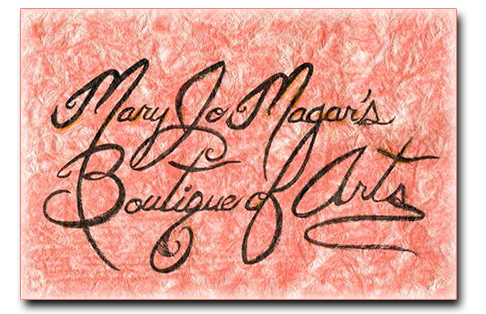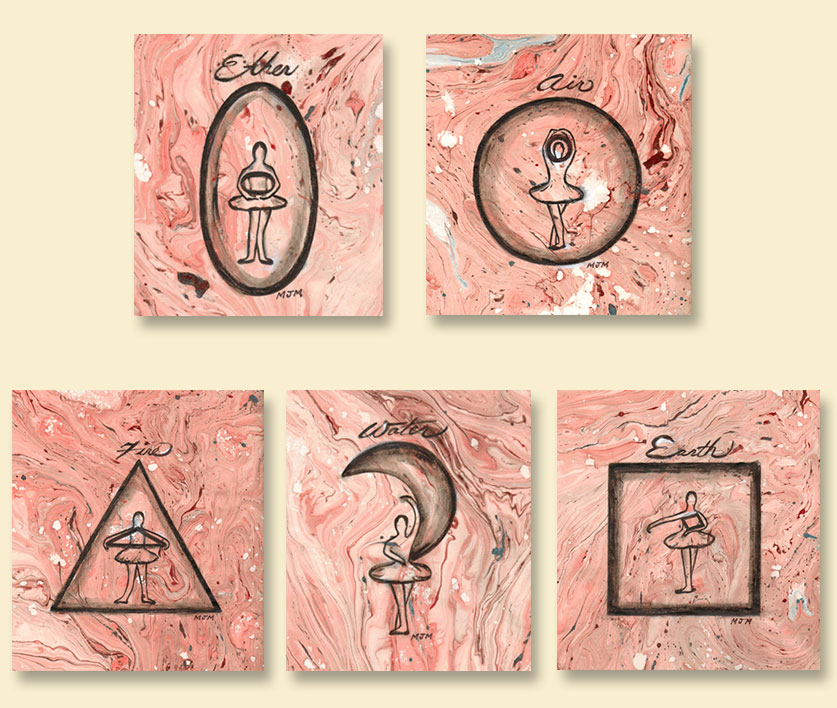Physio-Geometry: Theory and Practice
Depicted above, in their geometric expressions, are the five positions in ballet corresponding with the eternal five elements in nature. These five elements form the basis of life itself, hence, the basis for all arts and sciences, including medicine. I painted these designs on paper handmade of recycled pulp waste from various materials. The paper I marbleized using pulverized sea coral in its natural shades. The paint is pulverized shungite mixed with linseed oil and gum arabic. Shungite is a black Precambrian mineral rock found only in Karelia, Russia. Its composition includes nearly all elements of the Periodic Table, and it is the only natural mineraloid that contains fullerenes, which are geometric carbon molecules. Fullerenes, as well as shungite, have been the subject of much scientific research in the past twenty years and promise to reveal much medical value throughout the twenty-first century. Shungite-infused water has long been popular among Russian ballet dancers as a prophylactic and metabolic health tonic. Having drunk it myself, I can attest to its therapeutic value. In medieval Russia, shungite water and amber, both natural antibiotics, were widely used as effective defenses against disease.
All things in the world are parallel and analogical; it is no coincidence that as technology has boomed, technical emphasis in ballet has led to the modern neo-classical style, which emphasizes “athleticism” at the expense of human soul (and body too). Most of the great classical dancers of the past – founding dancers, in fact – were not great physical technicians by today’s standards but rather were spiritual technicians in that they sought to understand human nature and the human condition and “upload” that understanding to an audience through the matrix of movement combined with the abstraction of music.
At one time, classical dance was like prayer: it was not the act of praying or the words used that vitalized prayer’s effect but the depth of intent that commanded the gates of Heaven to open – or the hearts of an audience to open.
I highly recommend viewing the select offerings of Video Artists International as a means of “downloading” into one’s appreciation a quintessence of cultural style that has been supplanted by lesser values (in my opinion).
In classical ballet, all movement (from zero-point energy) proceeds from five basic positions, which can be analogized with the five elements of the universe. Ballet is essentially a mathematical exercise in time and counter time, which utilizes angles and the principle of “line” in which a dancer’s body literally draws in space and produces extension and continuity therein. The animate “poetry” of ballet issues from the union of science, which is technique, with art, which is expression of the natural five elements within an individual dancer / mover:
Ether / Oval – the primary (primeval) self
Air / Circle – the cognitive self
Fire / Triangle – the spiritual self
Water / Crescent – the emotional self
Earth / Square – the physical self
Mortal bodies united with the immortal expression of music produce a complete universe known as ballet. This same union of matter with energy – the visible with the invisible, the deceptively apparent with the absolute truth – produces the complete universe known as life. It is the purpose of science and art, separately and together, to present an understanding of every universe, every life, uniquely and commonly in performance.
The human body is a network of configurations in geometric language that serves the function called “living.” However, there is more to living than just functioning, and in learning this, ancient cultures devised methods of using the human body for greater self-expression than the mundane alone.
Through breath, intonations, gestures, postures, movements, and dance, the inherent and sacred geometry of the human form can identify and unite itself with life as a dynamic, infinite energy rather than a fixed, limited existence.
An example with which most people are familiar is the simple act of placing one’s hands together or folding one’s hands in prayer: this is a geometric configuration representing the divine union of opposites – masculine and feminine, conscious and subconscious, the two hemispheres of the brain united in concentration, etc. – and when fingers are extended upward (known in yoga as the añjali mudrā), the same “architecture” is created as in the spires of ancient cathedrals, even the spires of modern high rises – humankind’s outreach to a higher presence and the summoning of higher energies down through the spires or fingers.
Yoga, of course, in general, is among the most widely known practices of physiological geometry and was practiced by many cultures beyond the India of its presumed origin. The ancient Egyptians in particular utilized a well-defined system of applying human geometry to effect changes, not only in the human body itself, but in the world outside the body. Egyptian hieroglyphics are actually geometric depictions of a yoga in which specific hand gestures and body postures express alignment between earthly energies and celestial and divine energies, thus signifying universal harmony.
Of importance to mention is that yoga and other such bio-geometric practices, including martial arts, were never originally used as they often are now, with the primary intent of gaining physical fitness; rather, the ancients valued a well-developed spirit more than a well-developed body and in fact believed that attainment of robust physical health and prowess was almost entirely dependent upon spiritual and mental development, hence the true purpose of yoga.
Runic yoga is a less known but powerful physio-geometric practice that involves psycho-physical enactment of the Runic alphabet, the “Futhark,” which is an ancient Germanic system of writing that has influenced many languages including English, Gothic, German, Frisian, Danish, Swedish, Norwegian, Icelandic, Lithuanian, Russian, Hebrew and other Semitic languages. The Runes can be recognized in the alphabets of just about all European languages and certainly are evident in the English alphabet. However, it is an extreme oversimplification to call the Runes merely an alphabet for the reason that the shapes hold profound symbolic, primal meanings that transcend ordinary communication and instead “speak” directly to and from the universal mind, the cosmic consciousness, the collective unconscious.
Traditionally, Runic yoga is a means of using one’s mind and body to harness cosmic energies naturally present in the earth and atmosphere.
Related to Runic yoga is “Stáv,” which is the ancient Nordic form of martial art.
Runic yoga is very easy to perform in that it utilizes the upper body more than the lower, and most of the body positions are standing. More than that, Runic yoga cultivates an awareness of how alphabetic letters form words and words form thoughts that ultimately form our lives, which is why profanity and slang are so universally detrimental to the true value and purpose of language, not to mention wayward from its beauty.
In our prosaic consciousness, we tend to objectify words, perceiving them as existing separately from ourselves, outside ourselves, even though words originate within us, culturally and individually, as we express what we feel and think. Just as humanity is formed of individuals, language is formed of individual words, which are formed of individual letters or characters. In many ancient cultures, every letter of an alphabet possessed as much meaning as a word or words, in some cases more, such as the Runes and such as Hebrew, which is based on the human hand. Letters were considered configurations of sacred geometry, and the words that letters formed built castles of the mind, ultimately the structure of humanity and the architecture of civilization, in all its intended grandeur.

